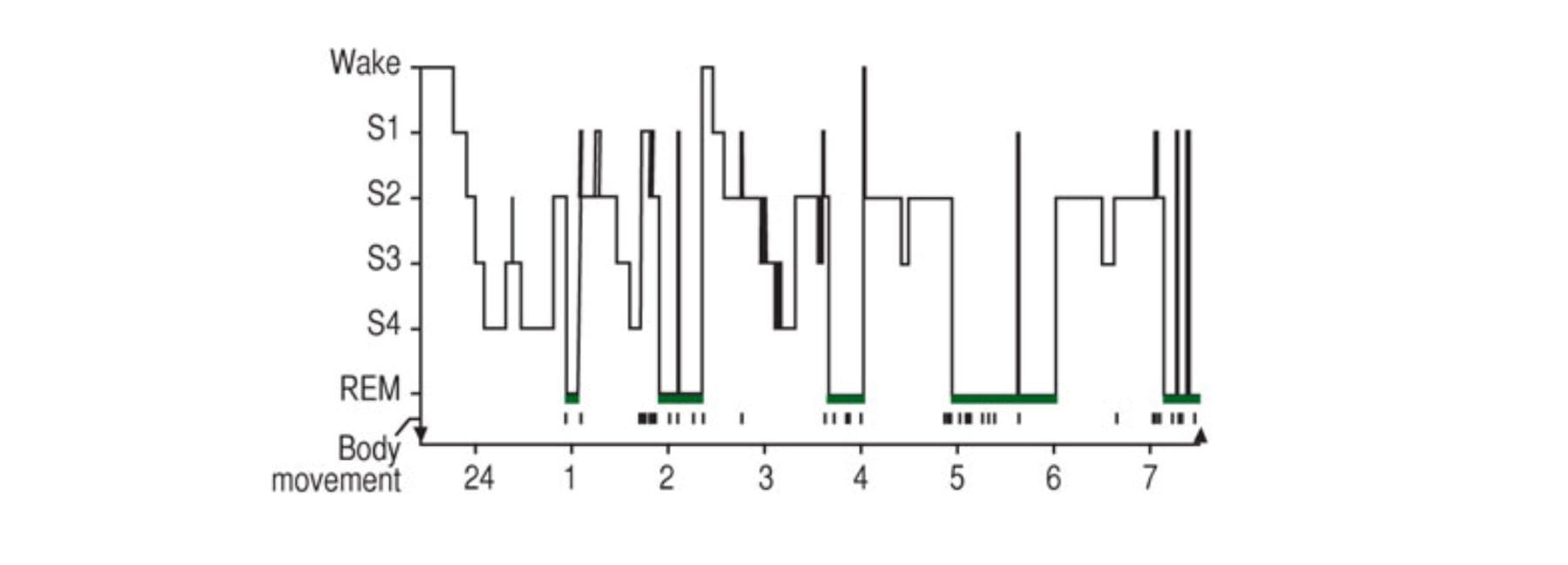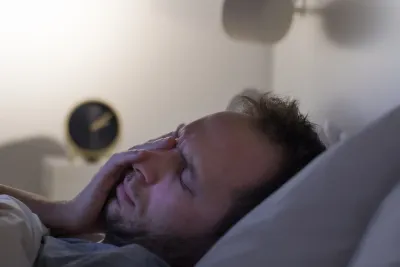What Are the Different Types of Sleep Stages?
Ana Marie Schick: Resident Sleep Expert and Certified Health Coach • Nov 07, 2024

Key Takeaways
- Sleep Stages: Four total—three Non-REM and one REM—all serve unique recovery roles.
- Deep Sleep: N3 is your body’s repair zone—vital for feeling restored.
- REM Sleep: Boosts memory, mood, and learning; where dreams go wild.
- Cycle Flow: Sleep runs in 90-minute loops, shifting deeper as night goes on.
- Smarter Sleep: Knowing your stages = better rest and recovery hacks.
There are two types of sleep, Non-Rapid Eye Movement (NREM) and Rapid Eye Movement (REM), and they occur in four stages, with NREM having 3 stages and REM being its own stage. While sleeping, your brain usually goes through cycles of these four stages about 4-6 times a night!
The hypnogram below shows how these sleep cycles look: As you can see, during sleep, your brain journeys through these four stages, and all four generally involve changes in muscle tone, brain activity, and eye movements. [1]
Each cycle can last approximately 70-120 minutes, with an average of 90 minutes. Also, each sleep cycle can last progressively longer. Normally, you will spend 75% of your total sleep time in NREM and the remaining 25% in REM sleep. [2]

(Images Source: The Gatorade Sports Science Institute)
The sleep stages generally involve changes in muscle tone, brain activity, and eye movements. [3]
Save Up to 20% - Adjust the Temperature for Better Sleep
Everyone sleeps best at their own personalized temperature. Our cooling mattress pad lets you customize your bed’s climate—anywhere from 55°F to 115°F. Shop our sale and start sleeping better!
How Many Sleep Stages Are There?
As mentioned above, there are four sleep stages. Each stage plays a unique role in maintaining brain health and performance by making needed repairs and maintenance.
- Stages 1 through 3 are a type of sleep known as non-rapid eye movement (NREM) sleep.
- Stage 4 is a type of sleep known as rapid eye movement (REM) sleep. It can be referred to as active sleep.
Wait. Aren't there five stages of sleep?
The American Academy of Sleep Medicine used to recognize five stages of sleep, but sleep was redefined to four stages in 2007.
What about “Core Sleep?” What is that?
"Core Sleep" is Apple's term for Light Sleep. It is not a scientifically recognized stage of sleep, but if you track your sleep with an Apple Watch, this is what your Light Sleep (Stages 1 & 2) will be categorized as. See this article for more information on the term “Core Sleep.”
Taking a Closer Look at Sleep
A lot of what scientists know about the nature of sleep comes from studies of volunteer patients who spent the night in a sleep lab hooked up to an electroencephalograph, more commonly called an EEG.
The neurons in your brain "talk" to each other through waves of energy. EEG records five different speeds of brain waves..
From the fastest waves in light sleep to the slowest waves in deep sleep, these types of brain waves are called:
- Gamma
- Beta
- Alpha
- Theta
- Delta

(Images Source: ScienceDirect)
As you drift from wakefulness into the realm of slumber, your brain waves undergo a fascinating transformation.
In Stage 1 of sleep, theta waves dominate, creating a state of drowsiness and semi-consciousness. These waves serve as a bridge between wakefulness and deeper sleep, allowing you to gradually transition into the next stage.
In Stage 2, theta waves continue to play a significant role, but they are joined by sleep spindles and K-complexes. Sleep spindles are brief bursts of activity that are associated with memory consolidation, while K-complexes are larger, slower waves that are often associated with arousals.
In Stage 3 represents the deepest and most restorative phase of sleep, characterized by the presence of delta waves. These slow waves are essential for physical and mental rejuvenation, promoting tissue repair, muscle growth, and cognitive restoration.
These brain waves play a vital role in overall well-being, influencing everything from emotional state to physical health. Understanding these wave patterns and their significance can help you optimize your sleep and promote a healthier, more balanced life.
Related Blog: How to Naturally Incease Your Deep Sleep
What are the Stages of Sleep?
What's going on in the four stages of sleep? The Cliff Notes version of what happens during the four stages of sleep is something like this:
- NREM Stage 1 (Lightest Sleep)
- NREM Stage 2 (Light Sleep)
- NREM Stage 3 (Deep Sleep)
- REM Stage 4
Some of the best sleep podcasts break down big sleep topics—like understanding the stages of sleep—so you can rest easy knowing exactly what’s going on while you snooze.
NREM Stage 1 (Lightest Sleep)
This first stage is relatively simple to understand. “Bedtime” is when your body receives signals that it’s time to go to sleep, like the sun going down, and melatonin is released. Your “sleep switch” activates, and your body is ready for sleep. [Saper, 2010]
Related Blog: Effective Tips to Reset and Fix Your Sleep Schedule
For the first five to ten minutes, you go through a transition period from wakefulness to sleep. You spend just 5% of your total sleep time in this stage. Your brain is still producing a good amount of theta waves.
These theta waves are mostly generated in your frontal cortex, the "executive" center of your brain. Muscle tone is still present, and your breathing is regular. Once you settle in, your muscles relax, your heart rate declines and your brain waves abate, preparing you for sleep.[2]
If someone wakes from this stage of sleep, you might tell them you were still awake, even though you weren't. Psychic phenomena are common in NREM Stage 1 or light sleep. You might experience a hallucination of some kind. It could be visual (even with your eyes closed) or auditory (even if you are wearing earplugs).
You can also have hallucinations involving taste or smell. Your muscles may twitch suddenly or jerk violently. You may have the sensation of falling or spinning around. Usually, you won't remember these sensations when you wake up.

2. NREM Stage 2 (Light Sleep)
NREM Stage 2 is also known as light sleep. For the next 20 minutes, your heart rate and breathing slow down and become more regular. Additionally, your muscles relax more, and your body temperature continues to drop. You become less aware of your surroundings.
During this time, eye movements stop, and brain waves show a new pattern. Your brain begins to produce waves known as "sleep spindles," and “K complexes,” an indication that you are processing what you have learned during the day and that you are forming new memories.
These sleep spindles and K complexes are the most distinct of all brain waves seen on EEG and indicate that you are moving into a deeper stage of sleep.
Usually, someone can wake you fairly easily, or you may wake up to a loud noise during NREM Stage 2. While the first N2 sleep stage lasts 10-25 minutes, each following cycle lasts longer.
The American Sleep Foundation estimates that most people spend about half of their sleep time in Stage 2.
Scientists have observed that N2 sleep is important for filing, storing, and retrieving memories [4]. So, if you want to make sure you really learn that new skill or are able to recall facts on trivia night, you want to make sure you get enough N2 sleep!
Fast Sleep Fact: Ever wake yourself up grinding your teeth? This is called “bruxism,” and it most often happens during NREM Stage 2 sleep. [5]
NREM Stage 3 (Deep Sleep)
In NREM Stage 3, your brain produces deep, slow delta waves. During this stage of sleep, you probably won't be responsive to loud noises or changes in temperature.
It is harder for someone to wake you up. Your brain produces growth hormone when you are in Stage 3 sleep. This is the hormone that stimulates your body’s capability of muscle building and fat burning.
Because your body produces less growth hormone as you get older, getting insufficient deep sleep can contribute to weight gain. Your body also uses this stage of sleep to bolster your immune system. NREM Stage 3 is also the time your brain forms declarative memories.
This is the stage you need to be able to "sleep on" facts you have tried to memorize the day before, so you will remember them when you wake up.
Stage 3 sleep lasts 20 to 40 minutes.
REM Stage 4
In Rapid Eye Movement (REM) or Stage 4, your eyes move rapidly behind your closed eyelids like you are looking at things in a dream world.
During this stage, your body becomes immobilized while your brain becomes almost as active as when you are awake. Fortunately, assuming you don't suffer from a disorder of arousal, like sleepwalking, your muscles are paralyzed, so you can't act out your dreams.

What You Can Do to Improve Your Stages of Sleep
There is a long list of specific conditions that cause some people to lose sleep:
- Sleeping next to a snoring bed partner or being the person who does the snoring. Obstructive sleep apnea (OSA) interrupts sleep dozens or even hundreds of times every night for the person who has it and anyone who lives with it.
- The need to get up to urinate at night.
- Chronic pain, like arthritis and fibromyalgia.
- Restless leg syndrome.
- Anxiety, depression, and bipolar disorder.
- Chronic health conditions like asthma, obesity, Alzheimer's, Parkinson's, and heart disease.
- Excessive use of, or addiction to, stimulants such as caffeine and nicotine.
Suffering from one or any of these conditions may require medical intervention. Fortunate are those who do not have to deal with these impediments to a good night's sleep.
Sleep Temperature
Temperature is something that affects everyone's sleep, whether it’s sleeping cold or enjoying a warm, soothing bed temperature. Keep in mind that people fall asleep, stay asleep, and feel rested based on their body’s ability to experience a spectrum of different temperatures throughout the night.
Related Blog: 13 Tips on How to Stay Cool at Night
Sleeping in a Warm Bed
Some people unwind best in a warm and cozy bed, but when your bed is too warm, it can make it difficult to fall asleep. You may toss and turn until you are totally exhausted.
Once you finally fall asleep, complete Stage 1 sleep, and move into Stage 2, you might then find it difficult to reach Stage 3, or Deep Sleep. Deep Sleep likes it cool. Core body temperature requires a temperature drop to reach this restful and crucial stage of sleep.
Sleeping in a bed that is too warm can make it harder for your body to lower your core temperature.
Sleeping in a Cold Bed
In a cooler bed, you will likely toss and turn less, so you’ll fall asleep faster and ultimately sleep longer, allowing your brain to go through all the crucial stages of sleep so you’ll wake up feeling emotionally and physically refreshed. If you are interested in learning more, read our blog, The Benefits of Sleeping in Cooler Temperatures.
Final Thought
All in all, getting both NREM AND REM sleep play crucial roles in your overall sleep. Cycling through each sleep stage through the night is necessary for your physical and mental well-being. What behaviors and environmental factors can you tweak to support your body’s sleep process?
Sleep Stages FAQ's
Which Is Better, REM or Deep Sleep?
Neither REM nor deep sleep are better than the other. Both REM and deep sleep are important, as they serve different purposes. Deep sleep is crucial for physical restoration, muscle growth, and immune health, while REM sleep is vital for memory consolidation, learning, and emotional processing.
A balanced night’s sleep includes both stages, each contributing uniquely to overall health.
Can Certain Sleep Disorders Affect the Sleep Stages?
Yes, certain sleep disorders, like insomnia, sleep apnea, and narcolepsy, can disrupt normal sleep stages. These conditions may prevent the body from progressing smoothly through the sleep cycle, affecting both the quality and restorative benefits of sleep.
How Can You Track Your Sleep Stages?
You can track your sleep stages using wearables such as smartwatches, rings, or dedicated sleep trackers, which analyze your movement and heart rate to estimate the amount of light, deep, and REM sleep you experience throughout the night.
Some phone apps and bedside devices also use sensors or microphones to monitor your sleep patterns and break down your sleep cycles in an easy-to-read graph
What is Core Sleep?
Apple uses the term "Core Sleep" in its Apple Watch sleep tracking feature, but it's not a scientifically recognized sleep stage. In Apple's sleep tracking, Core Sleep is equivalent to Light Sleep, which is when your body is still active, but rest and recovery begin. If you track your sleep with an Apple Watch, your Core Sleep data reflects your Light Sleep cycles.
References
[1] Van Cauter, E., & Plat, L. (1996). Physiology of growth hormone secretion during sleep. The Journal of pediatrics, 128(5 Pt 2), S32–S37. View Study
[2] Ibid
[3] Ibid
[4] Ibid
[5] Ibid









